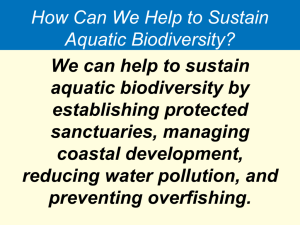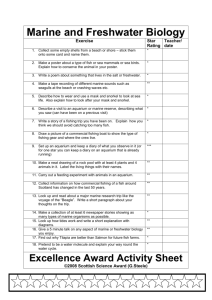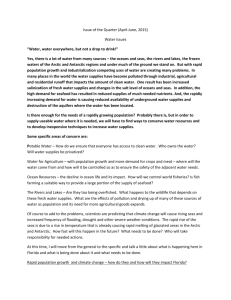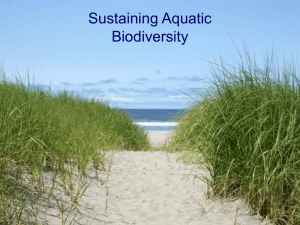Sustaining Aquatic Biodiversity
advertisement
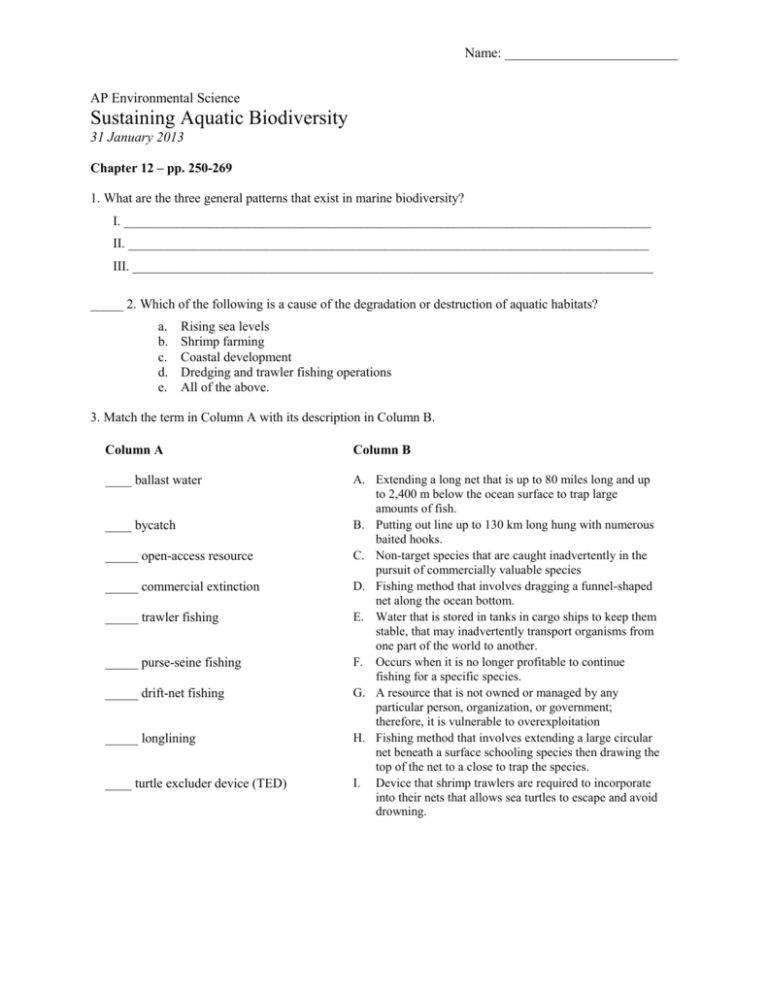
Name: _________________________ AP Environmental Science Sustaining Aquatic Biodiversity 31 January 2013 Chapter 12 – pp. 250-269 1. What are the three general patterns that exist in marine biodiversity? I. ________________________________________________________________________________ II. _______________________________________________________________________________ III. _______________________________________________________________________________ _____ 2. Which of the following is a cause of the degradation or destruction of aquatic habitats? a. b. c. d. e. Rising sea levels Shrimp farming Coastal development Dredging and trawler fishing operations All of the above. 3. Match the term in Column A with its description in Column B. Column A Column B ____ ballast water A. Extending a long net that is up to 80 miles long and up to 2,400 m below the ocean surface to trap large amounts of fish. B. Putting out line up to 130 km long hung with numerous baited hooks. C. Non-target species that are caught inadvertently in the pursuit of commercially valuable species D. Fishing method that involves dragging a funnel-shaped net along the ocean bottom. E. Water that is stored in tanks in cargo ships to keep them stable, that may inadvertently transport organisms from one part of the world to another. F. Occurs when it is no longer profitable to continue fishing for a specific species. G. A resource that is not owned or managed by any particular person, organization, or government; therefore, it is vulnerable to overexploitation H. Fishing method that involves extending a large circular net beneath a surface schooling species then drawing the top of the net to a close to trap the species. I. Device that shrimp trawlers are required to incorporate into their nets that allows sea turtles to escape and avoid drowning. ____ bycatch _____ open-access resource _____ commercial extinction _____ trawler fishing _____ purse-seine fishing _____ drift-net fishing _____ longlining ____ turtle excluder device (TED) 4. What do you think would be the best way to institute and enforce controls over the environmentally harmful fish harvesting methods described on pp 254-255? ______________________________________________________________________________________ ______________________________________________________________________________________ ______________________________________________________________________________________ ______________________________________________________________________________________ 5. Mark each statement as either TRUE or FALSE. _____ a. The majority of water pollution comes from land based sources. _____ b. Smaller fishes are most vulnerable to overfishing, followed by the large species that prey upon them. _____ c. Up to 30% of the fish caught worldwide and countless birds and mammals are killed unnecessarily as bycatch. _____ d. Marine and freshwater fish are threatened with extinction by human activities more than any other group of species. _____ e. Six of the world’s seven sea turtle species are threatened or endangered. _____ f. Since 1986, all nations have observed an International Whaling Commission (IWC) moratorium on whale hunting. 6. List FOUR reasons why aquatic biodiversity is difficult to protect. I. ________________________________________________________________________________ II. _______________________________________________________________________________ III. _______________________________________________________________________________ IV. _______________________________________________________________________________ _____ 7. Which of the following is NOT a factor that has led to the decline in the number of Florida Manatees? a. b. c. d. e. Collisions with speeding boats or propellers Entanglement in fishing lines and nets Degradation of underwater sea grass beds Heated water released by industrial operations or nuclear power plants Invasive species like water hyacinth that clog waterways impairing manatee navigation 8. Select ONE of the factors from question #7 and explain a strategy that could be used to protect the Florida Manatee from the impact of this factor and prevent its premature extinction. ______________________________________________________________________________________ ______________________________________________________________________________________ ______________________________________________________________________________________ ______________________________________________________________________________________ ______________________________________________________________________________________ ______________________________________________________________________________________ ______________________________________________________________________________________ ______________________________________________________________________________________ 9. Describe TWO economic aspects and TWO biological characteristics of whales that make them vulnerable to hunting and have led to their commercial extinction. ECONOMIC VALUE BIOLOGICAL CHARACTERISTICS 1. 1. 2. 2. 10. Contrast a nation’s exclusive economic zone and the high seas. _________________________________________________________________________________________ _________________________________________________________________________________________ _________________________________________________________________________________________ 11. Support the argument that the establishment of marine protected areas and marine reserves can actually increase the profitability of local fisheries. _________________________________________________________________________________________ _________________________________________________________________________________________ _________________________________________________________________________________________ _________________________________________________________________________________________ _________________________________________________________________________________________ _________________________________________________________________________________________ 12. _______________ _________________ ________________ is a community-based effort to develop and use coastal resources more sustainably. 13. Define the following terms: a. Maximum sustained yield ___________________________________________________________ ________________________________________________________________________________ b. Optimum sustained yield ____________________________________________________________ _________________________________________________________________________________ c. Multispecies management ____________________________________________________________ _________________________________________________________________________________ d. Comanagement ____________________________________________________________________ _________________________________________________________________________________ e. Mitigation banking _________________________________________________________________ _________________________________________________________________________________ 14. Hypothesize TWO reasons why most created (mitigated) wetlands fail to replace lost ones. a. __________________________________________________________________________________ __________________________________________________________________________________ b. __________________________________________________________________________________ __________________________________________________________________________________ 15. Read the Case Study on the Florida Everglades on pages 264-265. List THREE human practices that had led to the degradation of South Florida’s wetlands. Summarize FIVE goals of the U.S. Army Corp of Engineer’s Comprehensive Everglades Restoration Plan. Case Study of the Florida Everglades Human Practices that Degrade Florida Wetlands Goals of the Army Corps of Engineers Comprehensive Everglades Restoration Plan 1. 1. 2. 2. 3. 3. 4. 5. 15. Match the term in Column A with its description in Column B. Column A Column B ____ wild river A. Rivers that are relatively inaccessible, untamed, and are not permitted to be widened, straightened, dredged, filled, or dammed. B. Rivers with great aesthetic value that are free of dams, mostly undeveloped, and only accessible in a few places. C. Rivers that are readily accessible and may have some dams and shoreline development. ____ scenic river _____ recreational river 16. Complete the following table for the listed invasive species. Invasive Species Environmental/Commercial Impact Solutions (Why is this species damaging to ecosystems or potentially costly to humans?) (How do we reduce or eliminate the problem caused by this species?) Nile perch Asian swamp eel Purple loosestrife Caluerpa taxifolia Sea lamprey Zebra mussel Quagga mussel In addition, the following pieces of legislation will be discussed in class. While you do not have to research them for homework, you should note that you are responsible for learning their main provisions. They will be discussed in class. 1979 Global Treaty on Migratory Species U.S. Marine Mammal Protection Act of 1972 U.S. Whale Conservation and Protection Act of 1976 Marine Protection, Research, and Sanctuaries Act of 1972 Fishery Conservation and Management Act of 1976, 1978, 1982 Anadromous Fish Conservation Act of 1965 Coastal Barrier Resources Act of 1982 Fur Seal Act of 1966 National Coastal Zone Management Act of 1972, 1980 National Wild and Scenic Rivers Act of 1968
